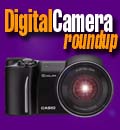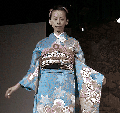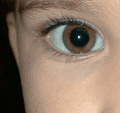|
Olympus Stylus FE-170, FE-180, FE-190
What do Olympus' 6-megapixel "Easy & Fun" compacts offer and which is the best?
(by Conrad H. Blickenstorfer)
Let's say you want to spend under US$200 for a new digital camera and have always liked Olympus. You're in luck because this past summer the company announced four new FE-Series point-and-shoot digital cameras. They are all in Olympus' "Easy & Fun" category, a class of inexpensive cameras that are meant to combine stylish design and a friendly user interface to give consumers, and especially those new to digicams, a fulfilling digital experience. The FE series has been around, but the four new cameras are slimmer, more compact and have several new features. All use Digital Image Stabilization, all have a large 2.5-inch LCD display, all pack a gratifying 6.0-megapixel punch, and the top-end FE-200 even has a big 5x optical zoom. And there are other new goodies. The addition of an on-screen "Help Guide," the reduced prices, and the simplified menus all indicate that Olympus is serious about making the switch to digital a pleasant, rewarding experience to first-time users. Gone are the days where low-end digital cameras meant low resolution, a tiny LCD, yet a steep learning curve because nothing made much sense.
There is, however, a new problem. While paying less than US$200 for a six megapixel camera would have seemed impossible only a few years ago, it's still money, and you want to buy the right camera for your needs. To our way of thinking, that puts the US$249 FE-200 into a different realm from the 170/180/190. True, all have a nice, large LCD and all have 6-megapixel resolution, but the 5X optical zoom of the FE-200 makes the top FE "Easy & Fun" camera appeal to people who want a big zoom. They will get that model and never even consider the other new members of the families that all share a standard 3X optical zoom. The difference is huge, and so this review centers around the lower end models that all cost
less than US$200.
So which one to get? Should you simply pick the least expensive one, the US$149 FE-170 and use the money you save to buy a nice, high capacity xD-Picture Card? Or do you assume that Olympus undoubtedly gives you a better camera for fifty bucks more and go for the US$199 FE-190? Or should you do what most car buyers do - select a middle-of-the-road model - and get the US$179 FE-180? We've used all three cameras for several weeks and can tell you upfront that all are good buys, but they are also different.
And one is definitely the best buy.
When you first look at the boxes the come in, and at the specifications, they sure seem almost identical. Same 6-megapixel imager, same 3X optical zoom lens, same size LCD, same materials and colors, same buttons and operating controls, same menus.
But they are not the same. They are not the same size. They don't weigh the same. They do not use the same batteries. They don't have the same "buzzword" technologies. They don't have the same screen resolutions. They don't shoot movies at the same pace and the same resolution. They don't have the same amount of internal memory. They don't have the same outer connectors. And the picture quality varies.
So let's look at each:
The Stylus FE-170:
With a list price of USS$149, this is the least expensive of the three, and it is also the largest. It measures 3.6 x 2.5 x 1.2 inches and weighs 6 ounces including a set of
two alkaline batteries. You can use Ni-MH cells, but you need to buy the batteries and the charger. At first sight, the body is almost identical to that of the FE-180. Both have a "power bulge" to accommodate
two AA cells. However, it's only the overall "look" of their bodies that is almost identical. In fact, almost every detail is different. The flash is different, providing more range in wide mode and less in telephoto. The display has more resolution - 154k pixel - than those of the other two that are limited to a meager 110k pixel. Yet, despite the higher res, the FE-170 display is softer and fuzzier.
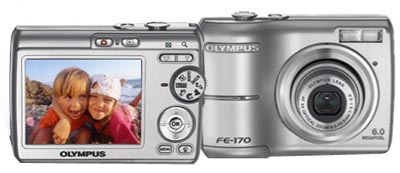
Those who like to take movie clips will find little of substance in the FE-170. Movies are limited to a no longer very acceptable 320 x 240 format at a leisurely 15 frames per second. No audio either, and no zooming during movies. That was okay a few years ago, but in a 6-megapixel camera it is, well, one of the concessions you make for the low price. Another is that internal memory is just 10MB, barely enough for six images. The beancounters at Olympus also nixed the TruePic TURBO Image Processor. That imaging technology improves color fidelity by applying optimal adjustment to color and luminance signals as opposed to applying the same to both. Advanced filters optimize the signal-to-noise ratio, resulting in clarity and detail, and tight integration of the TURBO processor into the camera's overall functioning speeds everything up. True enough, the FE-170 was slower than the other two, and image detail was not as bright and crisp. That also may have something to do with the ISO 400 limit whereas the other two go all the way up to ISO 1000.
On the interface side, the FE-170 has separate video out and USSB ports. Since it doesn't do sound and doesn't have a microphone, a combined USB/AV out connector was not needed. There is a DC jack for the optional AC/DC adapter.
The Stylus FE-180:
The middle-of-the-road FE-180 costs $30 more than the FE-180. Despite many details being a bit different, it shares the overall look and design of the FE-170. When you open the box you immediately see that you get something extra - a charger for the supplied
two AA NiMH batteries. Given that FE-170 customers will either have to buy boatloads of batteries or spring for a charger, that addition alone would probably justify the extra thirty bucks. However, there's more.
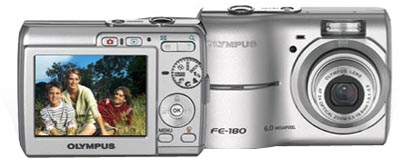
For some reason. Though at 3.5 x 2.4 x 1.1 inches the FE-180 is just a little bit smaller and weighs the same six ounces when loaded with a set of rechargeables, it does look and feel smaller. While it can be vexing to pay more for a lower resolution display, the 110k pixel LCD shared between the FE-180 and FE-190 is no worse. In fact, it actually looks better than the higher res screen of the FE-170. Thanks to the TruePic TURBO Image Processor, the FE-180 feels quite a bit quicker than the FE-170, and pictures are definitely sharper and cleaner.
Those who like to take movie clips will love the FE-180. Not only can you
shoot in full 640 x 480 mode, but you also get audio and you can record at 30 frames per second. That makes a huge difference for lifelike recording. Further, unlike with the FE-170, you can use the optical zoom while shooting movies. Another big plus. You also get 22MB of internal memory instead of just 10 with the less expensive model. That is still no big deal, but at least it can tide you over with 15 shots in 6-megabyte mode until you
locate, or make room on, a memory card.
With onboard audio (though sadly no audio clips or voice recording), the FE-180 uses a combined A/V out mini-USB connector.
Overall, the $30 price difference between the FE-180 and FE-170 is more than justified. You get a set of rechargeables, a battery charger, more than twice the internal memory, and higher resolution, higher quality movies with zoom and sound. And the
ISO 1000 max and the onboard TruePic TURBO processor make this a faster camera that takes better pictures. No contest.
The Stylus FE-190:
Now it gets interesting. That's because the FE-190 is a much lighter and much more elegant camera than its lesser siblings. That's accomplished by replacing the voluminous
pair of AA batteries with a small 3.7 Volt/740mAH Li-Ion rechargeable power
pack(let). The footprint stays roughly the same at 3.6 x 2.3 inches, but the camera is much thinner, just 0.7 inches. And it only weighs 4.5 ounces including battery. That is a big difference and gives the FE-190 that sleek, stylish contemporary look everyone loves. I know, we
always stress how much we like standard AA batteries because they cost less and can be
found anywhere. And far be it from us to criticize Olympus' choice to supply the FE-170/180 with two full AAs in order to give them
good battery life and great flexibility, but the FE-190 does look darn good...
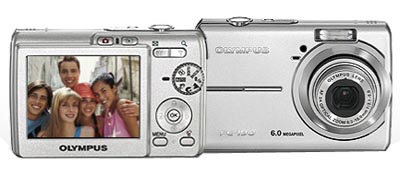
So the extra $20 the FE-190 costs over the FE-180 gets you the sleeker look. The LCD remains the same, as does the internal 22MB memory. Both have the TruePic TURBO Image Processor. With some of our test images one camera had the edge, in
others the other. Overall they perform the same. However, poking around the menus of the FE-190 reveals a disappointing shortfall: no 640 x 480 movie mode! You can shoot at 30 frames per second and you get sound with the movies and you can zoom, but only at 320 x 240 pixels. We really can't think of a reason why this should be so, but it is. This alone may disqualify the FE-190 for those who love to take video clips.
So whether or not the FE-190 is the camera of choice among those three will be a matter of preference. If sleekness matters, it's no contest. This is by far the handiest and most elegant of the three. However, the low-res movie mode is a downer, and the little, and expensive, Li-Ion pack
has its pros and cons. Power draw characteristics between different battery technologies affect how many pictures it lasts in a digital camera, but in terms of watt-hours, the little Li-Ion tablet packs about the same punch as a couple of rechargeable NiMH AAs.
What they all share:
Olympus has a bit of a history of trying out all sorts of button placements and controls, and also of having somewhat unwieldy onscreen menus.
I am pleased to report that the FE series cameras couldn't be simpler. All share the control placement and layout. Power button and shutter on top; record and playback neatly separated with a red and a green push button, a clearly marked mode wheel; equally clearly marked Menu and garbage buttons, and a standard navigation disc that provides access to other functions (macro, printing, flash, self timer). All three share the same icon/text-based menu system. Record and Playback show different main menu screens when you push the "menu" button. From there you select functions that may either bring up a selection list (such as image quality) that may include "walking" menus for sub-selections. Below is the main menu screen of the Stylus FE-190:
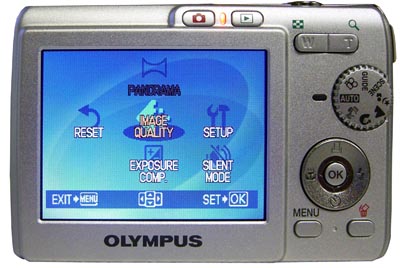
All cameras are point & shooters. A scene mode allows access to ten optimized settings; the most commonly used ones (portrait, landscape, night) are on the mode wheel, as is the movie mode and the digital anti-shake mode. A special "Shooting Guide" mode lists 11 situations and guides the user through doing the proper settings. Very clever. Picture quality is very good. And with six megapixel at your disposal, you don't even need to crop closely.
Below you see the scene selection menu. It starts out showing a sample image of the scene type, and then an explanation.
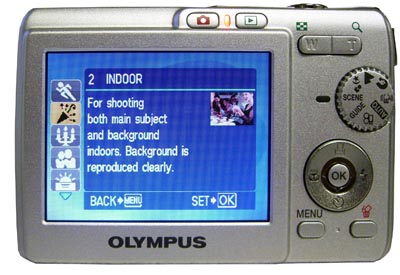
The picture below shows the "Shooting Guide" screen. If you were to select the first item, "Brightening Subject," the camera would then go to a second screen from where you can increase exposure and
set the flash to fill-in mode. Very handy.
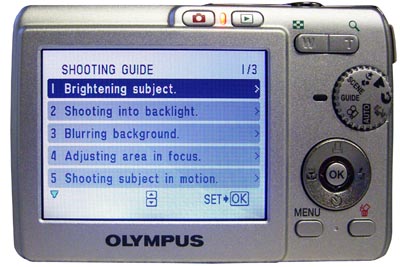
And the winner is:
While the lowest price is always good, the FE-170, a fine camera in its own right, is not the best deal. The lack of a charger, limited ISO range, less internal memory, the lack of Olympus' excellent TURBO image processor, the silent, low-res/no zoom movie mode all conspire to relegate the FE-170 to a third place finish. It's a good camera, but its cost/benefit cannot match that of its siblings.
The sleek and slender FE-190 is far sexier than the bulkier lower-end models and it has a lot to offer. But the sleekness also means a spare battery costs a lot more than standard AAs. And, inexplicably, the FE-190 is saddled with a 320 x 240 pixel movie mode. To our way of thinking, top model in a lineup cannot offer less than the one below it. And 320 x 240 is awfully small these days.
So our favorite in this lineup is the Stylus FE-180. It's a very nice 6-megapixel camera with a good lens, good digital image stabilization, a decent 2.5-inch display, speedy 640 x 480 movies with sound and zoom, and a nice 22MB of internal memory for when you run out of space on your memory
card. Its two NiMH rechargeables perform well, and cheap replacements are everywhere.
This camera offers an awful lot for its list price of US$179.99.
Stylus FE-170
We like:
- Very low price for a good 6.0 megapixel camera
- Higher-res screen than its pricier siblings
- Uses standard AA batteries
- Jack for optional A/C adapter
Not so much:
- No audio
- Doesn't come with rechargeable batteries or charger
- 320 x 240 video without sound or zoom
- Lack of TruePic TURBO processor visible in lesser picture quality
- Limited ISO range (400 max)
- Only 10MB onboard meemory
Stylus FE-180
We like:
- Comes with rechargeable AAs and charger
- Has 640 x 480 movies with sound and zoom
- TruePic TURBO processor and image stabilization combine for great shots
- 22MB of internal memory to tide you over
- Great balance of low price and features
Not so much:
- No audio clips or voice recording
- Heavier and bulkier than FE-190
Stylus FE-190
We like:
- Sleeker and lighter than the others
- TruePic TURBO processor and image stabilization combine for great shots
- Great 5X zoom, superb image stabilization
- 22MB of internal memory to tide you over
Not so much:
- No audio clips or voice recording
- Only has 320 x 240 video mode (with sound and zoom, though)
|
